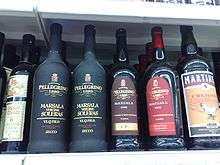Marsala wine
Marsala is a fortified wine, dry or sweet, produced in the region surrounding the Italian city of Marsala in Sicily. Marsala first received Denominazione di Origine Controllata (DOC) status in 1969.[1] The European Union grants Protected Designation of Origin (PDO) status to Marsala, and most other countries limit the use of the term Marsala to products from the Marsala area.[2]

While unfortified wine is produced in the Marsala region, it does not qualify for the Marsala DOC.[3]
History
Marsala fortified wine was probably first popularized outside Sicily by the English trader John Woodhouse. In 1773, he landed at the port of Marsala and discovered the local wine produced in the region, which was aged in wooden casks and tasted similar to Spanish and Portuguese fortified wines then popular in England.[4] Fortified Marsala was, and is, made using a process called in perpetuum, which is similar to the solera system used to produce Sherry in Jerez, Spain.[5]
Woodhouse recognized that the in perpetuum process raised the alcohol level and alcoholic taste of this wine while also preserving these characteristics during long-distance sea travel. Woodhouse further believed that fortified Marsala would be popular in England. Marsala indeed proved so successful that Woodhouse returned to Sicily and, in 1796, began its mass production and commercialization.[6] In 1806, it was Benjamin Ingham (1784–1861), arriving in Sicily from Leeds, who opened new markets for Marsala in Europe and the Americas.[7]
In 1833, the entrepreneur Vincenzo Florio, a Calabrese by birth and Palermitano by adoption, bought up great swathes of land between the two largest established Marsala producers and set to making his own vintage with even more exclusive range of grape.[8]
Florio purchased Woodhouse's firm, among others, in the late nineteenth century and consolidated the Marsala wine industry. Florio and Pellegrino remain the leading producers of Marsala today.[9]
Characteristics and types

Marsala is produced using the Grillo, Inzolia, Catarratto and Damaschino[10] white grape varietals, among others.[11]
Marsala contains about 15–20% alcohol by volume. Different Marsala wines are classified according to their color, sweetness, and the duration of their aging. The three levels of sweetness are secco (with a maximum 40 grams of residual sugar per liter), semisecco (41–100 g/l) and sweet (over 100 g/l). The color and aging classifications are as follows:[12]
- Oro has a golden color
- Ambra has an amber color. The coloring comes from the mosto cotto sweetener added to the wine
- Rubino has a ruby color, made from red grape varieties such as Perricone, Nero d'Avola and Nerello Mascalese[13]
- Fine has aging of at least one year[14]
- Superiore is aged at least two years
- Superiore Riserva is aged at least four years
- Vergine and/or Soleras is aged at least five years
- Vergine and/or Soleras Stravecchio and Vergine and/or Soleras Riserva is aged at least ten years[11]
Marsala wine was traditionally served as an aperitif between the first and second courses of a meal. Contemporary diners will serve its drier versions chilled with Parmesan (stravecchio), Gorgonzola, Roquefort, and other spicy cheeses, with fruits or pastries, and the sweeter at room temperature as a dessert wine.[1] Marsala is sometimes discussed with another Sicilian wine, Passito di Pantelleria (Pantelleria Island's raisin wine).[15]
In cooking
Marsala wine is frequently used in cooking, and is especially prevalent in dishes served in Italian restaurants in the United States.
Dry Marsala wine is used in savory cooking. A typical savory Marsala sauce, for example, involves reducing the wine almost to a syrup with onions or shallots, then adding mushrooms and herbs. One of the most popular Marsala recipes is chicken marsala, in which flour-coated pounded chicken breast halves are braised in a mixture of Marsala, butter, olive oil, mushrooms, and spices.[16] Marsala is also used in some risotto recipes.
Sweet Marsala wine is used to produce rich Italian desserts such as zabaglione, tiramisu and shortcake.[17]
See also
- Albanello Bianco, another Sicilian grape variety used to make a notable eighteenth-century Marsala-style wine Ambrato di Comiso.
References
- Scagliarini, Loris. "Marsala Wine Characteristics". WineCountry.IT. Archived from the original on 2006-10-06. Retrieved 2007-12-24.
- "Labelling of wine and certain other wine sector products". Europa.eu. Retrieved 12 March 2013.
- "Sicily's Most Interesting but Nearly Extinct Wine"
- winepros.com.au, The Oxford Companion to Wine, Marsala Archived 2008-08-08 at the Wayback Machine
- Biancalana, Antonello (June 2007). "Wine Producers: Florio". DiWineTaste. Retrieved 2007-12-24.
- Bridle, James. "Marsala Ice Cream". Cooking With Booze website. Archived from the original on 2007-11-14. Retrieved 2007-12-04.
- "Benjamin Ingham - The Florentine". 28 May 2015.
- "Marsala". SicilyWeb. Retrieved 2007-12-04.
- Thomson, Patricia (July 2003). "Sicilian Wine Reborn: A New Breed of Winemakers Is Shaking Up Sicily". Tastes OF Italia Magazine (via La Dolce Vita Wine Tours website). Archived from the original on 2008-01-01. Retrieved 2007-12-24.
- DiWineTaste, Antonello Biancalana - ProMIND software development -. "Articolo DiWineTaste: Marsala".
- Bicais, Ben. "Marsala". Calwineries. Retrieved 2007-12-24.
- J. Robinson (ed) The Oxford Companion to Wine Third Edition p. 428–429 Oxford University Press 2006 ISBN 0-19-860990-6
- P. Saunders Wine Label Language pp. 176 Firefly Books 2004 ISBN 1-55297-720-X
- "Info" (PDF). ler.letras.up.pt.
- Italian Trade Commission (2006-03-16). "Enoteca 2006: Mariani Sheds Light on Marsala". Italian Trade Commission (New York). Archived from the original on 2007-07-22. Retrieved 2007-12-24.
- Rogers, Cathy. "What is Chicken Marsala?". wiseGeek.com. Retrieved 2007-12-04.
- "Florio Marsala Recipes". Banfi Vintners. Archived from the original on 2007-12-01. Retrieved 2007-12-04.